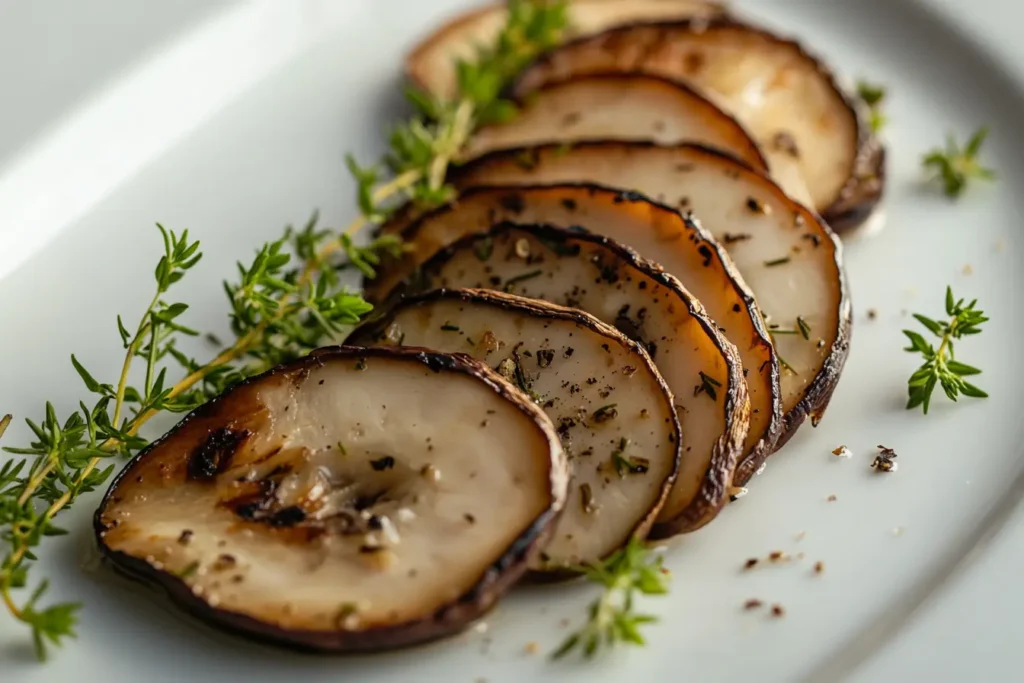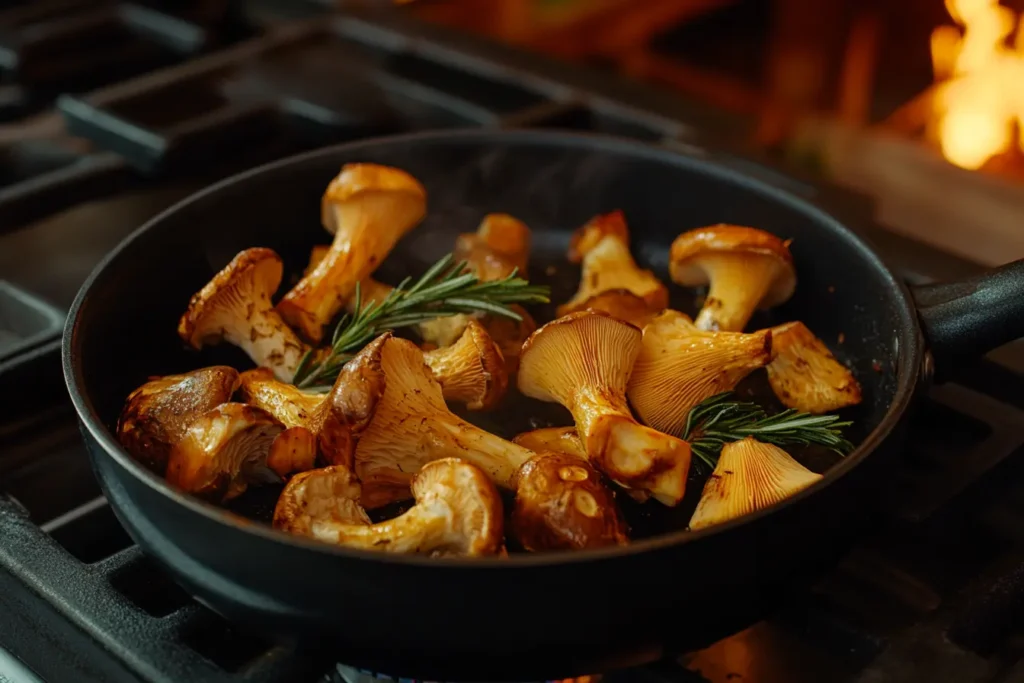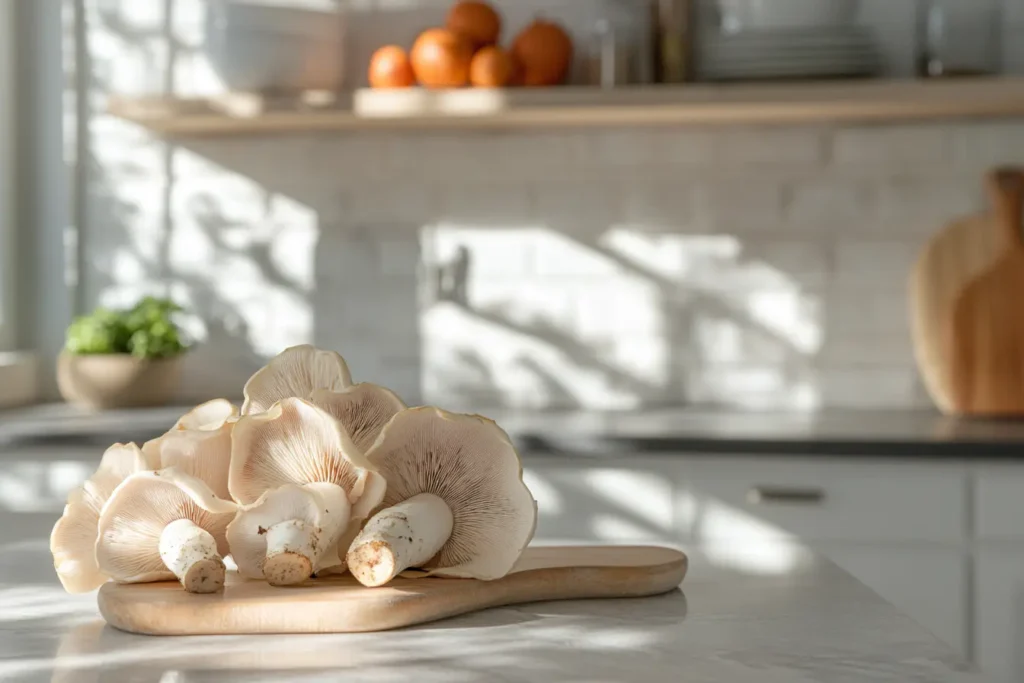
Mushrooms are a fascinating part of nature. Not only do they come in a variety of shapes, colors, and sizes, but they also add a lot of flavor and texture to food. Among the many types of mushrooms, King Oyster and King Trumpet are two names that often cause confusion. Are they the same mushroom? Or are they two different varieties?
The answer isn’t as straightforward as you might think. While some people use these names interchangeably, others believe they refer to completely different mushrooms. This article will dive deep into the topic to explain whether King Oyster and King Trumpet are the same, their unique characteristics, and how to use them in cooking.
Similarities Between King Oyster and King Trumpet Mushrooms
King Oyster and King Trumpet mushrooms are essentially the same species, so it’s no surprise that they share numerous similarities. Understanding these shared traits can help clear up the confusion surrounding their names.
1. Shared Scientific Classification:
Both King Oyster and King Trumpet mushrooms belong to the species Pleurotus eryngii. This scientific name confirms that they are biologically identical. While their names may differ due to cultural or marketing preferences, their genetic makeup is the same.
2. Appearance:
Both mushrooms feature a thick, cylindrical stem and a small, slightly curved cap. Their resemblance to a trumpet or a drumstick gives them their characteristic look. This shape makes them highly recognizable and distinguishes them from other mushroom varieties like Shiitake or Button mushrooms.
3. Flavor Profile:
The taste of both mushrooms is mild and earthy, with a hint of nuttiness. They both absorb seasonings and marinades exceptionally well, making them versatile ingredients for a wide range of recipes. Their subtle flavor serves as an excellent base for both simple and complex dishes.
4. Texture:
Both King Oyster and King Trumpet mushrooms have a dense, meaty texture. This chewy consistency makes them popular in plant-based diets as a substitute for seafood or meat. Whether they’re grilled, pan-fried, or roasted, their texture remains satisfying and hearty.
5. Culinary Uses:
Both mushrooms are incredibly versatile in the kitchen. They can be prepared using the same methods, such as sautéing, grilling, roasting, or stir-frying. Their stems can even be sliced into rounds to create vegan “scallops,” a favorite among plant-based cooks.
6. Nutritional Value:
Both types are rich in essential nutrients like potassium, phosphorus, and vitamins B2 and B3. They are also low in calories, high in fiber, and contain antioxidants, making them a healthy addition to any diet.
Key Differences Between King Oyster and King Trumpet Mushrooms
While King Oyster and King Trumpet mushrooms are biologically the same, subtle differences can arise due to factors like cultivation methods, regional names, and slight variations in size or flavor perception. Here are some of the key distinctions that might contribute to the confusion:
1. Terminology:
The most obvious difference lies in their names. The term “King Oyster” is widely used in Asian markets and recipes, while “King Trumpet” is more common in Europe and North America. This difference in terminology can make it seem like they are separate mushrooms, even though they are not.
2. Cultivation and Size:
The way mushrooms are grown can affect their size and appearance. For example, King Oyster mushrooms cultivated in Asia may appear slightly larger or more elongated compared to King Trumpet mushrooms grown in Western countries. However, these differences are due to environmental factors like temperature, humidity, and farming practices rather than inherent biological traits.
3. Flavor Nuances:
While the flavor is generally the same, some people claim to notice subtle differences based on how the mushrooms are cooked. King Trumpet mushrooms are sometimes described as slightly sweeter, while King Oyster mushrooms may have a deeper umami flavor. This likely depends more on preparation methods than the mushrooms themselves.
4. Cultural Presentation:
In Asian cuisine, King Oyster mushrooms are often featured in dishes where their large, meaty stems are emphasized, such as braised dishes or stir-fries. In Western cuisine, King Trumpet mushrooms are more commonly included in roasted vegetable medleys or creamy soups. These cultural differences can contribute to the perception that they are distinct varieties.

How to Cook with King Oyster and King Trumpet Mushrooms
Both King Oyster and King Trumpet mushrooms are incredibly versatile ingredients that can elevate your cooking. Their mild flavor and firm texture make them suitable for a variety of dishes, from appetizers to main courses. Below are tips and ideas for cooking with these mushrooms.
1. Preparation Tips:
- Cleaning: Use a damp cloth or a soft brush to remove dirt. Avoid soaking the mushrooms in water, as they can absorb moisture and lose their texture.
- Trimming: Trim the ends of the stems if they appear tough or dry.
- Slicing: The stems can be sliced into rounds, strips, or halves, depending on the recipe.
2. Cooking Techniques:
- Grilling: Brush the mushrooms with olive oil and season with salt, pepper, and herbs. Grill over medium heat until tender and slightly charred.
- Pan-Frying: Slice the stems into thick rounds to create vegan “scallops.” Sear them in a hot pan with garlic, butter, and a splash of soy sauce.
- Roasting: Toss the mushrooms with olive oil, salt, and your favorite spices. Roast in the oven at 400°F (200°C) for 20–25 minutes until golden brown.
- Stir-Frying: Add sliced mushrooms to a wok with vegetables, soy sauce, and ginger for a quick and healthy meal.
3. Flavor Pairings:
These mushrooms pair well with ingredients like garlic, thyme, rosemary, soy sauce, balsamic vinegar, and lemon. They also complement proteins like tofu, chicken, or fish.
Popular Recipes for King Oyster Mushrooms
Here are some delicious recipes that showcase the versatility of King Oyster mushrooms:
- Vegan Scallops: Slice the stems into thick rounds and pan-sear them with garlic and olive oil. Serve with a drizzle of lemon juice.
- King Oyster Stir-Fry: Stir-fry thinly sliced mushrooms with bell peppers, onions, and a soy-ginger sauce.
- Grilled Mushrooms: Marinate the mushrooms in balsamic vinegar, olive oil, and herbs, then grill until tender.
Popular Recipes for King Trumpet Mushrooms
For King Trumpet mushrooms, try these mouthwatering dishes:
- Creamy Mushroom Pasta: Sauté the mushrooms in butter and garlic, then toss with pasta and a creamy sauce.
- Roasted Mushroom Medley: Combine King Trumpet mushrooms with other vegetables like zucchini and bell peppers for a flavorful roasted side dish.
- Mushroom Soup: Dice the mushrooms and cook them into a creamy, comforting soup with herbs and vegetable stock.
Are There Any Health Benefits of King Oyster and King Trumpet Mushrooms?
Mushrooms, in general, are known for their health benefits, and King Oyster and King Trumpet mushrooms are no exception. These mushrooms offer a range of nutrients and compounds that promote overall health. Here’s a closer look at their nutritional value and how they can benefit your body.
1. Rich in Nutrients:
Both King Oyster and King Trumpet mushrooms are packed with essential nutrients like potassium, phosphorus, and vitamins B2 (riboflavin) and B3 (niacin). These nutrients are crucial for maintaining healthy body functions:
- Potassium: Helps regulate blood pressure and supports muscle function.
- Phosphorus: Contributes to healthy bones and teeth.
- B-Vitamins: Aid in energy production and support brain health.
2. Low in Calories:
For those looking to maintain a healthy weight, these mushrooms are an excellent choice. They are low in calories yet filling due to their fiber content. This makes them a perfect addition to meals that are satisfying without being high in fat or sugar.
3. High in Antioxidants:
King Oyster and King Trumpet mushrooms contain antioxidants, which help fight free radicals in the body. This can reduce the risk of chronic diseases like heart disease and cancer, as well as slow down aging-related damage.
4. Supports Immune Health:
These mushrooms contain beta-glucans, a type of fiber that has been shown to boost the immune system. Beta-glucans can help the body fight off infections and improve overall immunity.
5. Promotes Digestive Health:
The dietary fiber in these mushrooms aids in digestion by promoting healthy gut bacteria. It can help prevent constipation and support a balanced digestive system.
6. Potential for Reducing Cholesterol:
Some studies suggest that compounds found in King Oyster and King Trumpet mushrooms, such as lovastatin, may help lower LDL (bad) cholesterol levels. This can contribute to better heart health over time.
Potential Risks or Allergies
While King Oyster and King Trumpet mushrooms are generally safe to eat, there are a few considerations to keep in mind to ensure a safe and enjoyable experience.
1. Allergies:
Although rare, some people may experience allergic reactions to mushrooms. Symptoms can include itching, swelling, or difficulty breathing. If you’re trying these mushrooms for the first time, it’s best to consume them in small quantities to rule out any adverse reactions.
2. Pesticides or Contaminants:
Like other produce, mushrooms may sometimes carry traces of pesticides or contaminants. To minimize this risk, purchase organic mushrooms when possible and thoroughly clean them before cooking.
3. Digestive Sensitivities:
Some individuals may have difficulty digesting mushrooms due to their high fiber content. If you have a sensitive stomach, start with smaller portions to see how your body reacts.
4. Proper Storage and Cooking:
Improperly stored mushrooms can spoil and lead to food poisoning. Always store them in the refrigerator and cook them thoroughly to eliminate any potential bacteria.

Frequently Asked Questions
Are King Oyster Mushrooms Expensive?
King Oyster mushrooms can be slightly more expensive than common varieties like Button or Portobello mushrooms, but their price varies depending on location and season. In regions where they are grown locally or imported in large quantities, they are relatively affordable. In Western countries, they might cost more due to limited availability or demand in specialty markets.
Curious about versatile mushrooms? Discover the uses of King Trumpet mushrooms, their culinary potential, and easy ways to cook them.
Can You Substitute One for the Other in Recipes?
Yes, you can substitute King Oyster mushrooms for King Trumpet mushrooms and vice versa because they are the same species. Their flavor and texture are so similar that most people won’t notice any difference in the final dish. However, the terms used in recipes might reflect regional naming conventions rather than actual differences.
How Do You Store These Mushrooms?
To keep King Oyster and King Trumpet mushrooms fresh:
- Store them in a paper bag or a breathable container in the refrigerator.
- Avoid using sealed plastic bags, as this can trap moisture and cause spoilage.
- Use them within 5–7 days for the best flavor and texture. If you can’t use them right away, they can also be sliced and frozen for later use.
For tips on preserving and preparing mushrooms, explore this guide on King Trumpet mushroom recipes.
Are These Mushrooms Suitable for Vegans?
Absolutely! King Oyster and King Trumpet mushrooms are plant-based and are widely used in vegan and vegetarian diets. Their meaty texture and ability to absorb flavors make them a great substitute for meat, fish, or seafood in recipes like vegan scallops, mushroom steaks, or hearty stews.
Do They Taste Different from Other Mushrooms?
Yes, King Oyster and King Trumpet mushrooms have a unique flavor compared to common varieties like White Button or Shiitake mushrooms. Their taste is mild, earthy, and slightly nutty, with a dense, chewy texture that sets them apart. They are less “mushroomy” in flavor, which makes them appealing to people who don’t typically enjoy mushrooms.
Try incorporating these mushrooms into flavorful dishes like our BBQ shrimp recipe for a smoky, meaty texture.
Where Can I Buy These Mushrooms?
King Oyster and King Trumpet mushrooms can be found in Asian grocery stores, specialty produce markets, and some well-stocked supermarkets. They are also available online through specialty food retailers.
Pair them with fresh ingredients for recipes like these perfect sides for barbecue shrimp.
Conclusion
King Oyster and King Trumpet mushrooms are indeed the same species, known scientifically as Pleurotus eryngii. The different names are simply a result of cultural and regional variations, leading to the confusion about whether they are distinct. Despite this, their shared characteristics—including their thick stems, mild flavor, and meaty texture—make them a versatile and nutritious ingredient in the kitchen.
Whether you call them King Oyster or King Trumpet, these mushrooms are a fantastic addition to soups, stir-fries, pastas, and even vegan dishes like “scallops” or grilled mushroom steaks. They are also packed with nutrients, including potassium, B-vitamins, and antioxidants, offering a range of health benefits.
